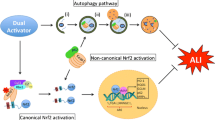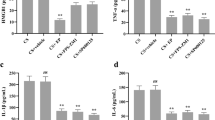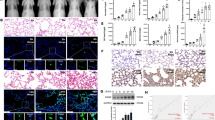Abstract
Objective
Apoptosis plays a major role in the progression of acute respiratory distress syndrome (ARDS) that may involve the interaction of the high mobility group box 1 (HMGB1) protein with the receptor for advanced glycation end products (RAGE). However, the underlying mechanism remains unclear. Thus, we aimed to explore the mechanisms of HMGB1-RAGE axis-induced apoptosis in ARDS.
Methods
Blood samples from ARDS patients and healthy volunteers were collected to investigate the correlation between serum HMGB1 levels and the severity of ARDS in patients. Mouse models of ARDS induced by caecal ligation and perforation and A549 cell models established by stimulation with recombinant human HMGB1 (rHMGB1) were designed to explore lung inflammatory injury and apoptosis.
Results
Serum HMGB1 levels were significantly increased in ARDS patients compared to controls, and HMGB1 levels in the Severe group and Nonsurvival group were significantly higher than those in the Mild and Moderate group and Survival group. In vivo, compared to sham mice, ARDS mice showed significant lung inflammatory injury and apoptosis as well as upregulation of HMGB1 and RAGE and endoplasmic reticulum stress (ERs) protein expression. All injury was attenuated by treatment with an HMGB1 inhibitor GA, a RAGE blocker FPS-ZM1, and an ERs inhibitor 4-PBA. In vitro, A549 cells challenged with rHMGB1 exhibited significant increases in the levels of proteins in the RNA-like endoplasmic reticulum kinase (PERK)/eukaryotic initiation factor 2alpha (eIF2α)/activating transcription factor 4 (ATF4) pathway and in apoptosis, all of which were significantly inhibited by pre-treatment with lenti-shPERK and an anti-RAGE antibody.
Conclusion
The HMGB1-RAGE axis induces apoptotic injury during ARDS, possibly through PERK/eIF2α/ATF4-mediated ERs.








Similar content being viewed by others
Data availability
The datasets used and/or analyzed during the current study are available from the corresponding author on reasonable request.
Abbreviations
- ARDS:
-
Acute respiratory distress syndrome
- ATF4:
-
Activating transcription factor 4
- Bip:
-
Binding immunoglobulin protein
- BALF:
-
Bronchoalveolar lavage fluid
- CHOP:
-
C/EBP homologous protein
- CLP:
-
Caecal ligation and puncture
- eIF2α:
-
Eukaryotic translation-initiation factor 2α
- GA:
-
Glycyrrhizic acid
- HMGB1:
-
High mobility group protein
- IRE1α:
-
Inositol-requiring enzyme 1α
- IL-6:
-
Interleukin 6
- IL-1β:
-
Interleukin 1β
- PERK:
-
Protein kinase R-like ER kinase
- 4-PBA:
-
4-Phenylbutyricacid
- RAGE:
-
Receptor for advanced glycation end-products
- rHMGB1:
-
Recombinant high mobility group protein
- TNF-α:
-
Tumour necrosis factor-α
References
Sweeney RM, McAuley DF. Acute respiratory distress syndrome. Lancet. 2016;388:2416–30. https://doi.org/10.1016/S0140-6736(16)00578-X.
Matthay MA, Zemans RL, Zimmerman GA, Arabi YM, Beitler JR, Mercat A, et al. Acute respiratory distress syndrome. Nat Rev Dis Primers. 2019;5:18. https://doi.org/10.1038/s41572-019-0069-0.
Huppert LA, Matthay MA, Ware LB. Pathogenesis of acute respiratory distress syndrome. Semin Respir Crit Care Med. 2019;40:31–9. https://doi.org/10.1055/s-0039-1683996.
Peter JV, John P, Graham PL, Moran JL, George IA, Bersten A. Corticosteroids in the prevention and treatment of acute respiratory distress syndrome (ARDS) in adults: meta-analysis. BMJ. 2008;336:1006–9. https://doi.org/10.1136/bmj.39537.939039.BE.
Iwata K, Doi A, Ohji G, Oka H, Oba Y, Takimoto K, et al. Effect of neutrophil elastase inhibitor (sivelestat sodium) in the treatment of acute lung injury (ALI) and acute respiratory distress syndrome (ARDS): a systematic review and meta-analysis. Intern Med. 2010;49:2423–32. https://doi.org/10.2169/internalmedicine.49.4010.
Paine R 3rd, Standiford TJ, Dechert RE, Moss M, Martin GS, Rosenberg AL, et al. A randomized trial of recombinant human granulocyte-macrophage colony stimulating factor for patients with acute lung injury. Crit Care Med. 2012;40:90–7. https://doi.org/10.1097/CCM.0b013e31822d7bf0.
Gouda MM, Shaikh SB, Bhandary YP. Inflammatory and fibrinolytic system in acute respiratory distress syndrome. Lung. 2018;196:609–16. https://doi.org/10.1007/s00408-018-0150-6.
Lotze MT, Tracey KJ. High-mobility group box 1 protein (HMGB1): nuclear weapon in the immune arsenal. Nat Rev Immunol. 2005;5:331–4. https://doi.org/10.1038/nri1594.
Raucci A, Cugusi S, Antonelli A, Barabino SM, Monti L, Bierhaus A, et al. A soluble form of the receptor for advanced glycation endproducts (RAGE) is produced by proteolytic cleavage of the membrane-bound form by the sheddase a disintegrin and metalloprotease 10 (ADAM10). FASEB J. 2008;229:3716–27. https://doi.org/10.1096/fj.08-109033.
Katsuoka F, Kawakami Y, Arai T, Imuta H, Fujiwara M, Kanma H, et al. Type II alveolar epithelial cells in lung express receptor for advanced glycation end products (RAGE) gene. Biochem Biophys Res Commun. 1997;238:512–6. https://doi.org/10.1006/bbrc.1997.7263.
Weber DJ, Allette YM, Wilkes DS, White FA. The HMGB1-RAGE inflammatory pathway: implications for brain injury-induced pulmonary dysfunction. Antioxid Redox Signal. 2015;23:1316–28. https://doi.org/10.1089/ars.2015.6299.
Wang G, Liu L, Zhang Y, Han D, Liu J, Xu J, et al. Activation of PPARγ attenuates LPS-induced acute lung injury by inhibition of HMGB1-RAGE levels. Eur J Pharmacol. 2014;726:27–32. https://doi.org/10.1016/j.ejphar.2014.01.030.
Zhou H, Wang X, Zhang B. Depression of lncRNA NEAT1 antagonizes LPS-Evoked acute injury and inflammatory response in alveolar epithelial cells via HMGB1-RAGE signalling. Mediators Inflamm. 2020;2020:8019467. https://doi.org/10.1155/2020/8019467.
Kaufman RJ. Stress signalling from the lumen of the endoplasmic reticulum: coordination of gene transcriptional and translational controls. Genes Dev. 1999;13:1211–33. https://doi.org/10.1101/gad.13.10.1211.
Bettigole SE, Glimcher LH. Endoplasmic reticulum stress in immunity. Annu Rev Immunol. 2015;33:107–38. https://doi.org/10.1146/annurev-immunol-032414-112116.
Zhang K, Kaufman RJ. From endoplasmic-reticulum stress to the inflammatory response. Nature. 2008;454:455–62. https://doi.org/10.1038/nature07203.
Yuan X, Wang J, Li Y, He X, Niu B, Wu D, et al. Allergy immunotherapy restores airway epithelial barrier dysfunction through suppressing IL-25 -induced endoplasmic reticulum stress in asthma. Sci Rep. 2018;8:7950. https://doi.org/10.1038/s41598-018-26221-x.
Gu YH, Wang Y, Bai Y, Liu M, Wang HL. Endoplasmic reticulum stress and apoptosis via PERK-eIF2α-CHOP signalling in the methamphetamine-induced chronic pulmonary injury. Environ Toxicol Pharmacol. 2017;49:194–201. https://doi.org/10.1016/j.etap.2017.01.003.
Huang Q, Yang Z, Zhou JP, Luo Y. HMGB1 induces endothelial progenitor cells apoptosis via RAGE-dependent PERK/eIF2α pathway. Mol Cell Biochem. 2017;431:67–74. https://doi.org/10.1007/s11010-017-2976-2.
Ranieri VM, Rubenfeld GD, Thompson BT, Ferguson ND, Caldwell E, ARDS Definition Task Force, et al. Acute respiratory distress syndrome: the Berlin Definition. JAMA. 2012;307:2526–33. https://doi.org/10.1001/jama.2012.5669.
Qiang X, Yang WL, Wu R, Zhou M, Jacob A, Dong W, et al. Cold-inducible RNA-binding protein (CIRP) triggers inflammatory responses in hemorrhagic shock and sepsis. Nat Med. 2013;19:1489–95. https://doi.org/10.1038/nm.3368.
Chen J, Zhang W, Zhang L, Zhang J, Chen X, Yang M, et al. Glycyrrhetinic acid alleviates radiation-induced lung injury in mice. J Radiat Res. 2017;58:41–7. https://doi.org/10.1093/jrr/rrw091.
Lee H, Park JR, Kim WJ, Sundar IK, Rahman I, Park SM, et al. Blockade of RAGE ameliorates elastase-induced emphysema development and progression via RAGE-DAMP signaling. FAaSEB J. 2017;31:2076–89. https://doi.org/10.1096/fj.201601155R.
Lee HY, Marahatta A, Bhandary B, Kim HR, Chae HJ. 4-Phenylbutyric acid regulates CCl4-induced acute hepatic dyslipidemia in a mouse model: a mechanism-based PK/PD study. Eur J Pharmacol. 2016;777:104–12. https://doi.org/10.1016/j.ejphar.2016.02.068.
He F, Wang J, Liu Y, Wang X, Cai N, Wu C, et al. Xuebijing injection induces anti-inflammatory-like effects and downregulates the expression of TLR4 and NF-κB in lung injury caused by dichlorvos poisoning. Biomed Pharmacother. 2018;106:1404–11. https://doi.org/10.1016/j.biopha.2018.07.111.
Matute-Bello G, Downey G, Moore BB, Groshong SD, Matthay MA, Slutsky AS, et al. An official American Thoracic Society workshop report: features and measurements of experimental acute lung injury in animals. Am J Respir Cell Mol Biol. 2011;44:725–38. https://doi.org/10.1165/rcmb.2009-0210ST.
Luo Y, Li SJ, Yang J, Qiu YZ, Chen FP. HMGB1 induces an inflammatory response in endothelial cells via the RAGE-dependent endoplasmic reticulum stress pathway. Biochem Biophys Res Commun. 2013;438:732–8. https://doi.org/10.1016/j.bbrc.2013.07.098.
He B, Zhou W, Rui Y, Liu L, Chen B, Su X. MicroRNA-574-5p attenuates acute respiratory distress syndrome by targeting HMGB1. Am J Respir Cell Mol Biol. 2021;64:196–207. https://doi.org/10.1165/rcmb.2020-0112OC.
Fu J, Lin SH, Wang CJ, Li SY, Feng XY, Liu Q, et al. HMGB1 regulates IL-33 expression in acute respiratory distress syndrome. Int Immunopharmacol. 2016;38:267–74. https://doi.org/10.1016/j.intimp.2016.06.010.
Tseng CC, Fang WF, Leung SY, Chen HC, Chang YC, Wang CC, et al. Impact of serum biomarkers and clinical factors on intensive care unit mortality and 6-month outcome in relatively healthy patients with severe pneumonia and acute respiratory distress syndrome. Dis Markers. 2014;2014: 804654. https://doi.org/10.1155/2014/804654.
Andersson U, Tracey KJ. HMGB1 is a therapeutic target for sterile inflammation and infection. Annu Rev Immunol. 2011;29:139–62. https://doi.org/10.1146/annurev-immunol-030409-101323.
Sims GP, Rowe DC, Rietdijk ST, Herbst R, Coyle AJ. HMGB1 and RAGE in inflammation and cancer. Annu Rev Immunol. 2010;28:367–88. https://doi.org/10.1146/annurev.immunol.021908.132603.
Guillot L, Nathan N, Tabary O, Thouvenin G, Le Rouzic P, Corvol H, et al. Alveolar epithelial cells: master regulators of lung homeostasis. Int J Biochem Cell Biol. 2013;45:2568–73. https://doi.org/10.1016/j.biocel.2013.08.009.
Osorio F, Lambrecht B, Janssens S. The UPR and lung disease. Semin Immunopathol. 2013;35:293–306. https://doi.org/10.1007/s00281-013-0368-6.
Chen X, Wang Y, Xie X, Chen H, Zhu Q, Ge Z, et al. Heme oxygenase-1 reduces sepsis-induced endoplasmic reticulum stress and acute lung injury. Mediators Inflamm. 2018;2018:9413876. https://doi.org/10.1155/2018/9413876.
Song MJ, Davis CI, Lawrence GG, Margulies SS. Local influence of cell viability on stretch-induced permeability of alveolar epithelial cell monolayers. Cell Mol Bioeng. 2016;9:65–72. https://doi.org/10.1007/s12195-015-0405-8.
Li PC, Wang BR, Li CC, Lu X, Qian WS, Li YJ, et al. Seawater inhalation induces acute lung injury via ROS generation and the endoplasmic reticulum stress pathway. Int J Mol Med. 2018;41:2505–16. https://doi.org/10.3892/ijmm.2018.3486.
Liu W, Liu K, Zhang S, Shan L, Tang J. Tetramethylpyrazine showed therapeutic effects on sepsis-induced acute lung injury in rats by inhibiting endoplasmic reticulum stress protein kinase RNA-Like Endoplasmic Reticulum Kinase (PERK) signalling-induced apoptosis of pulmonary microvascular endothelial cells. Med Sci Monit. 2018;24:1225–31. https://doi.org/10.12659/msm.908616.
Acknowledgements
This study was supported by Nanjing Medical Science and technique Development Foundation (QRX17124). We would like to thank Mr. Xiangeng He and Ms. Xiaoshun Fang for giving us so much encouragement and support during this research period.
Author information
Authors and Affiliations
Contributions
CW and FH contributed to the conception and design of the study; NG, NC, JN, YL and FH performed research; NG, NC, JN and FH performed analysis and interpretation of data; YL, QZ and Fei He contributed to drafting the article or revising it critically for important intellectual content; all authors approve the final version to be submitted.
Corresponding authors
Ethics declarations
Conflict of interest
The authors declare that they have no competing interests.
Ethical approval
The clinical investigation in this study was approved by the Ethics Committee of Nanjing Drum Tower Hospital (EC 2020-089). All procedures for animal in this study were approved by the Institutional Animal Care and Use Committee at Nanjing Drum Tower Hospital, Nanjing University Medical School and conducted in accordance with the National Institutes of Health (NIH) Guide for the Care and Use of Laboratory Animals (NIH, Publication No. 86-23, revised 1996).
Additional information
Responsible Editor: Anatolii Kubyshkin.
Publisher's Note
Springer Nature remains neutral with regard to jurisdictional claims in published maps and institutional affiliations.
Fei He, Lina Gu and Nan Cai contributed equally to this work.
Supplementary Information
Below is the link to the electronic supplementary material.
Rights and permissions
About this article
Cite this article
He, F., Gu, L., Cai, N. et al. The HMGB1-RAGE axis induces apoptosis in acute respiratory distress syndrome through PERK/eIF2α/ATF4-mediated endoplasmic reticulum stress. Inflamm. Res. 71, 1245–1260 (2022). https://doi.org/10.1007/s00011-022-01613-y
Received:
Revised:
Accepted:
Published:
Issue Date:
DOI: https://doi.org/10.1007/s00011-022-01613-y




